You are here
Lassen Volcanic National Park Overview | Lassen's Hydrothermal Landscape | Southwest Entrance/South Lassen Park Road | Manzanita Lake Entrance/North Lassen Park Road | Butte Lake, Juniper Lake and Warner Valley Areas | Summer vs. Winter Recreation | Camping and Lodging | Pets
Lassen Volcanic National Park Overview
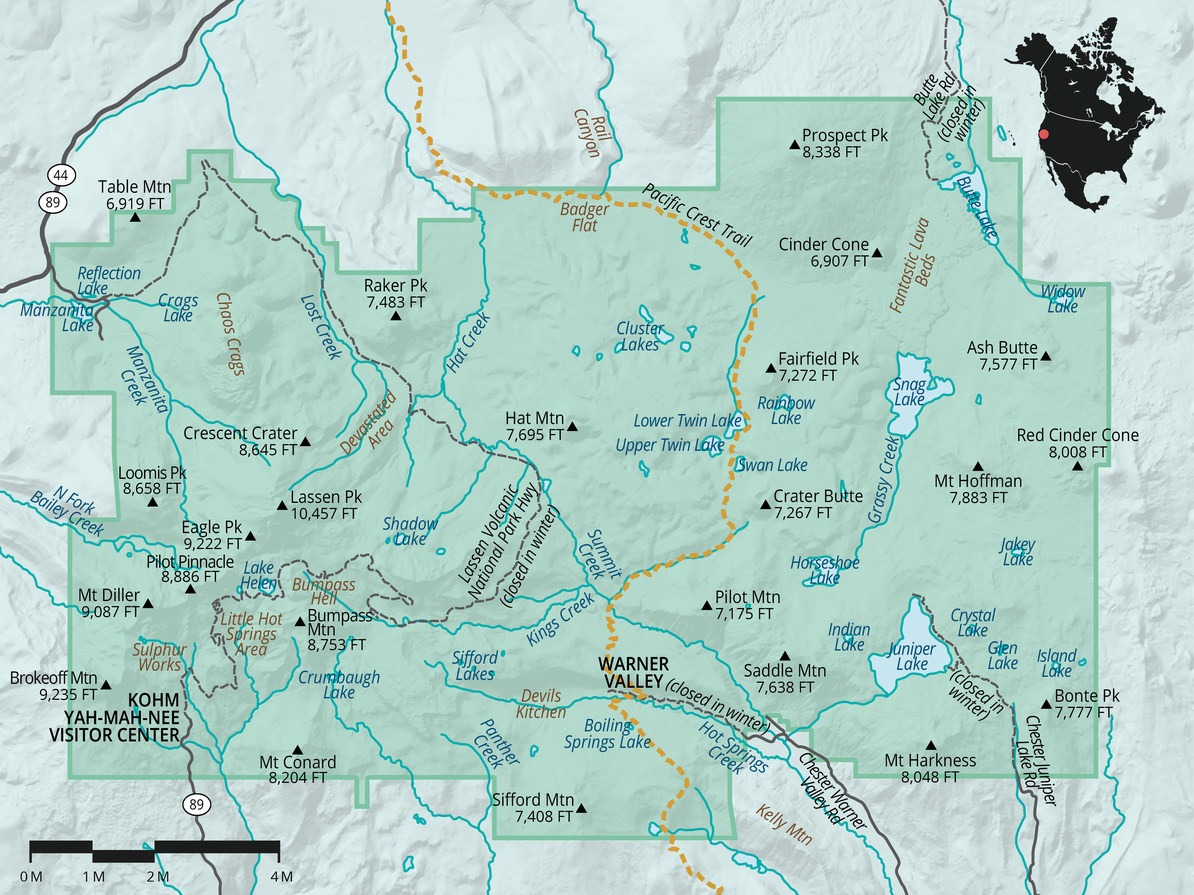
Six-hundred thousand years ago the composite volcano known as Mount Tehama first began to take shape, and with many successive eruptions over 200,000 years it grew to heights approaching 11,000 feet and achieved a mass that would dwarf the remaining peaks in Lassen Volcanic National Park. Glaciers and erosion wore the mighty volcano away over time, leaving only Pilot Pinnacle, Mount Diller, and Brokeoff Mountain as evidence of its size and legacy. But the volcanic activity in the area persisted. The largest existing formation, Lassen Peak, began forming on the flanks of the eroded Tehama roughly 27,000 years ago, and it has grown to 10,457 feet with a prominence of 2,000 feet and volume of half a cubic mile. In contrast to Tehama, Lassen is a plug dome volcano, one of the world's largest, and it was formed by the accumulation of magma that is generally more viscous because of its higher silica content.
According to the Maidu, one of several Native American groups that hunted in the area in the summer months, this massive peak they called Kohm Ya-mah-nee, or “Snow Mountain,” rose up from the great floods and became a source of heat and dry land for all. And this area still receives some of the highest snowfalls in all of California: Accumulations exceeding 30 feet at the base of the peak are not uncommon. Of the active volcanoes in the Cascade Range, Lassen is the farthest south, yet it receives more precipitation than neighboring Mount Shasta to the north. The forces of erosion that persistently ground Tehama down maintain their seasonal assaults on Lassen, and yet the mountain seems to respond with continued volcanic activity.
Most recently, Lassen Peak began a three-year period of intense eruptions on May 30, 1914. Rumbling and shaking preceded an explosion, and this initial blast was followed a month later by another that was famously photographed by Benjamin Loomis. As impressive as these eruptions were, they were just the opening acts. Nearly one year later, on May 22, 1915, a much larger and more destructive two-day eruption from the northeast aspect sent a cloud 5 miles into the sky and moved avalanche debris into drainages miles away. Loomis Hot Rock is a small example of the forces involved: Situated in what is now called the park’s Devastated Area, this gigantic boulder was spewed more than a mile from the mountain and remained hot for several days following the eruption. This 1915 eruption remained the largest in U.S. history until another Cascade volcano's spring burst: the Mount St. Helens eruption on May 18, 1980, a VEI-5 event, was significantly larger and more devastating than Lassen’s VEI-3 eruption.
Lassen Peak rumbled through an estimated 300 minor eruptions before 1921, when the peak fell into a calmer period, though area’s activity is still remarkable and one of the park’s main attractions. The bubbling mud, piping hot water, and pungent smells of thermal vents in areas like Bumpass Hell and Sulpher Works led Theodore Roosevelt to protect the area as Cinder Cone National Monument and Lassen Peak National Monument in 1907, just seven years before Lassen’s major eruptions started. The area’s promotion to a national park fell in the midst of this active period on August 9, 1916, just over two weeks before the establishment of the National Parks Service itself. Significantly, the Lassen Volcanic Wilderness was established in 1972 to further protect this unique landscape. Currently the 166-square-mile national park is home to strange and fascinating hydrothermal areas, but it is also home to huge areas of vital and regenerated habitat along with countless recreational opportunities.
One of the least visited national parks (entrance fees here are lower than other national parks such as Yosemite or Sequoia and Kings Canyon), most visitors stroll through the boardwalks and interpretive trails showcasing the hydrothermal activity and leave, but a significant portion of the park is available for hiking, fishing, camping, and other more ordinary but no less fulfilling national park pursuits. There are 51 lakes in this park, and there are miles of incredible trails that beg to be explored through summer and fall. Compared to busier national parks, you’ll have much more trail time to yourself. Winter in Lassen brings with it abundant recreational opportunities, as well. Until 2005, a 1960s chalet even operated near the southwest entrance that was dedicated to serving skiers throughout the winter season. The backcountry skiing opportunities here are truly unique; limited sections of the park highway are plowed near the southwest and north entrances, and the closed, snowy park road makes for an ideal avenue into the backcountry. Additionally, snowshoe and cross-country ski trails will have you enjoying winter solitude just a few minutes from your car, and there are sledding hills and restrooms at the southwest entrance.
Lassen's Hydrothermal Landscape
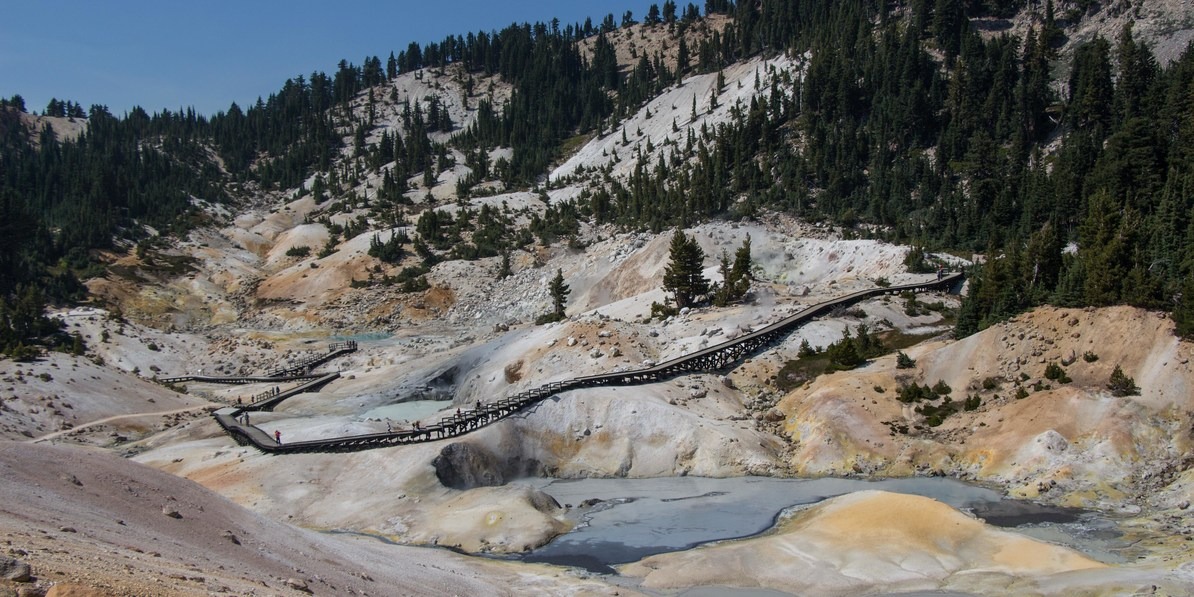
The long boardwalk leading through Bumpass Hell. Photo by Patrick Mueller.
Outside of Yellowstone, Lassen Volcanic National Park is one of the country's most accessible landscapes for an up-close look at active volcanism and hydrothermal displays. Fumaroles, steam vents, steaming creek beds, mud pots and boiling pools are all on exhibit in the park as surface indicators of the area’s underlying geothermal activity. This southernmost volcano in the Cascade Range (the bedrock transitions to the granite of the Sierra Nevada south of here) is truly a geothermal hotspot.
Lassen’s active hydrothermal areas are easily accessed during summer and fall months when the Lassen Park Road is open and visitors can drive within a short distance of the main attractions. Other hydrothermal areas can be fairly easily hiked to when trails are snow free. During winter, closed roads make the hydrothermal areas less accessible unless you’re prepared for a demanding and lengthy snowshoe or ski in. The one winter exception is found at Sulphur Works, where a relatively short mile-long snowshoe/ski or walk-in from the Kohm Yah-mah-nee Visitor Center affords access to mud pots and steam vents that contrast with the cold and snow-covered environment.
A word of caution: When visiting Lassen's hydrothermal areas, make sure to stay on designated trails. Visitors have been severely injured, burned and scalded from acidic boiling water or mud hiding beneath a thin crust disguised as solid ground; what appears as firm terrain in these areas can easily break. Stay out of steaming water, and remember that there are no soakable waters or hot springs within the park. The temperatures of these thermal pools far exceed what is considered safe. Likewise, if you will be exploring a hydrothermal area or if you happen upon one in winter, stay on designated trails when possible and/or give yourself a wide berth from hydrothermal features.
Lassen's main hydrothermal areas include:
- Bumpass Hell
- Sulphur Works
- Little Hot Springs Valley
- Devil's Kitchen
- Boiling Springs Lake
- Cold Boiling Lake
- Terminal Geyser
Southwest Entrance/South Lassen Park Road
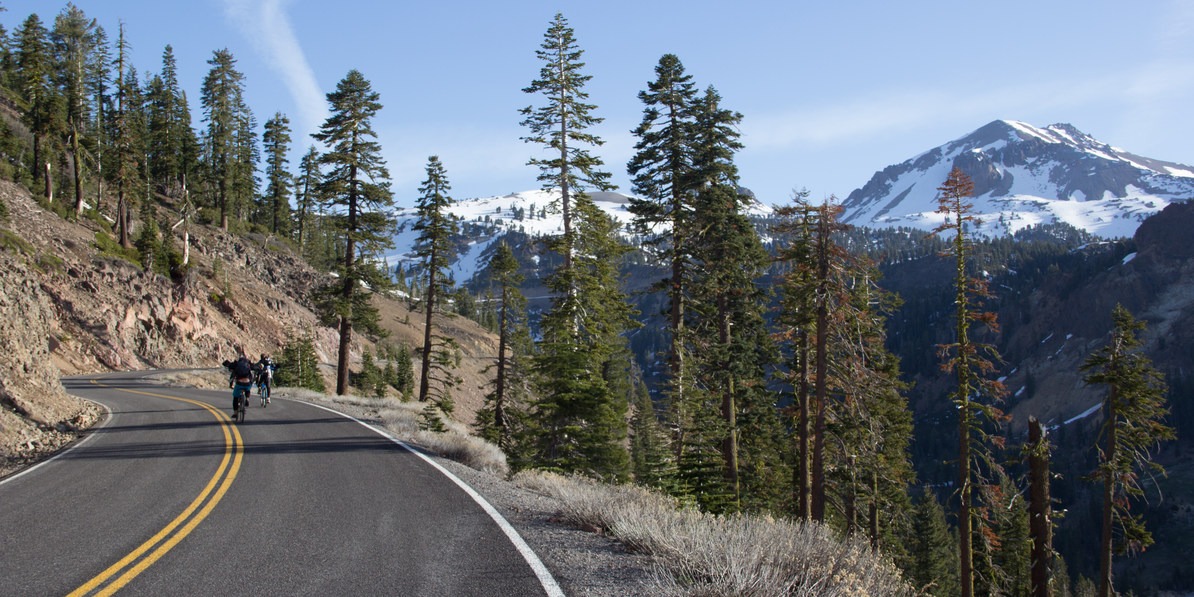
Biking up the Lassen Volcanic National Park Highway in early spring before the road is open to cars. Photo by Aron Bosworth.
The area accessed along the southern portion of the Lassen Park Road is where many of the park's best known landmarks lie. Here you'll find the Summit Trail leading up Lassen Peak itself, as well as some of the most accessible and impressive hydrothermal features in the park. During winter and spring when the Lassen Park Road is closed at the Kohm Yah-mah-nee Visitor Center, this area is also the focal point for winter recreation within the park. Highlights include:
- Lassen Peak Summit Trail
- Bumpass Hell
- Sulphur Works
- Ridge Lakes
- Ridge Lakes Snowshoe
- Brokeoff Mountain
- Cold Boiling + Crumbaugh Lakes
- Kings Creek Falls
- Mill Creek Falls
- Kings Creek Meadow
- Kohm Yah-mah-nee Visitor Center
- Southwest Walk-in Campground
Winter + Spring:
- Southwest Entrance Winter Recreation Area: snowshoeing, cross-country skiing, backcountry skiing, sledding options.
- Ridge Lakes Winter Camp
- Mount Diller and Pilot Pinnacle
- Brokeoff Mountain
- Skiing Lassen Peak via Summit Trailhead
Manzanita Lake Entrance/North Lassen Park Road
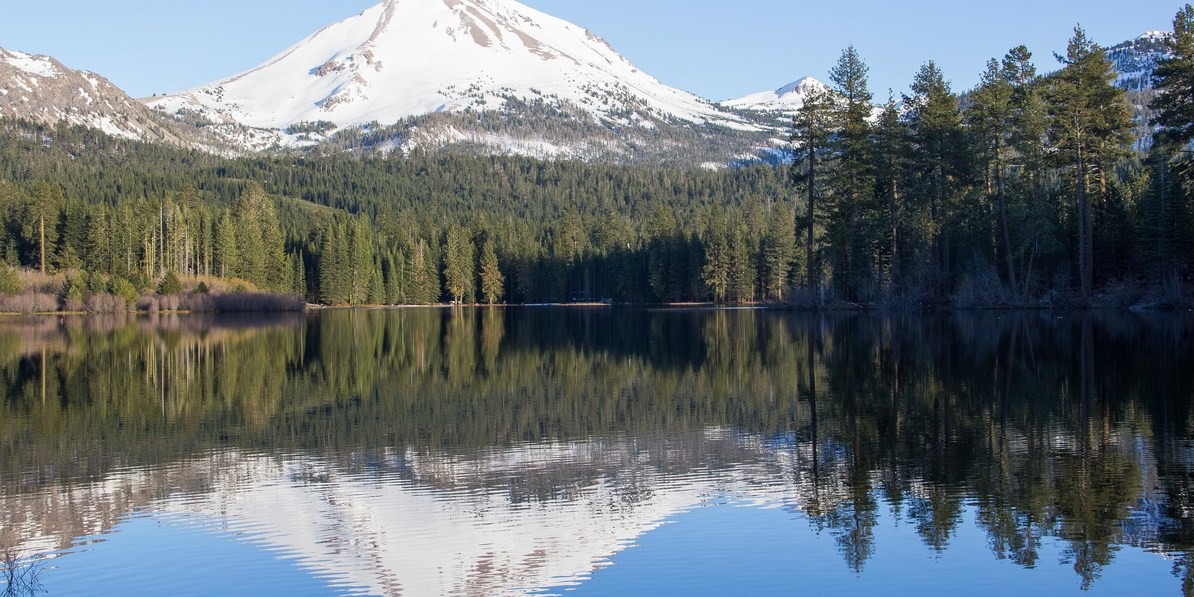
Lassen Peak from Manzanita Lake. Photo by Aron Bosworth.
The park's north entrance lies next to Manzanita Lake, Lassen's largest campground and a focal area for summer visitors. At 5,800 feet, the lake provides a beautiful backdrop for taking in Lassen's splendors and offers a spectacular view of Lassen Peak's prominence over the park. The Manzanita Lake facilities - a store, a museum, and boat rental service - are open for summer only; this corner tends to be much quieter than the southwest entrance during winter. But during peak season, family-oriented hiking trails, boating, fishing (Manzanita Lake is recognized as a blue ribbon fly fishery for trout), and ranger-led nature programs make Manzanita Lake a bustling base camp for exploring the park.
The northern section of the park road covers the area from Manzanita Lake to Summit Lake. During winter and spring the park road typically closes at Manzanita Lake. Note, however, on low snow years the north park road will sometimes remain open to the Devastated Area for a portion of the winter. Check the park's road conditions page for status.
- Manzanita Lake and Loop Trails
- Manzanita Lake Campground
- Loomis Museum
- Manzanita Creek Trail
- Crag Lake and Choas Crags Trail
- Devastated Area
- Hat Creek Trail and Paradise Meadows
- Twin Lakes Loop
- Summit Lake
- Summit Lake North Campground + South Campground
- Numerous backcountry trails connecting to Butte and Juniper Lakes
Winter and Spring:
- Manzanita Lake Loop Snowshoe
- Manzanita Creek Trail
- Snowshoeing and skiing options on Lassen Peak when the road to Devastated Area is open
Butte Lake, Juniper Lake and Warner Valley Areas
With each having individual access roads closed for winter and spring, the Butte Lake, Juniper Lake and Warner Valley areas are summer-only destinations within Lassen Volcanic National Park that are also off the beaten track. These further reaches are favorite destinations among long-time locals and offer a quieter volcanic landscape compared to the highlight summer attractions situated along Lassen Park Road. Butte and Juniper Lakes, both offering campgrounds and boat ramps, are popular among the kayak, SUP, and canoe crowd, and Butte Lake in particular is known for good trout fishing. Scenery around the lakes is punctuated with cinder cones and lava beds, an omnipresent reminder this is still volcano country. Highlights include:
- Butte Lake and Butte Lake Campground
- Bathtub Lake Loop
- Cinder Cone Trail
- Snag Lake Loop
- Juniper Lake and Campground
- Juniper Lake Loop
- Mount Harkness
- Horshoe Lake Trail
- Numerous backcountry trails connecting to the Lassen Park Road.
Transected by Hot Springs Creek, Warner Valley provides access to another of Lassen's concentrated hydrothermal active areas. Multiple hydrothermal features are located within short hikes from the Warner Valley Trailhead along the Pacific Crest Trail. Warner Valley has a summer campground as well as Lassen's only lodging option apart from the Manzanita Lake cabins at Drakesbad Guest Ranch.
Highlights include:
- Boiling Springs Lake
- Terminal Geyser
- Devils Kitchen
- Warner Valley Campground
- Backcountry trails connecting to the Lassen Park Road
Summer vs. Winter Recreation
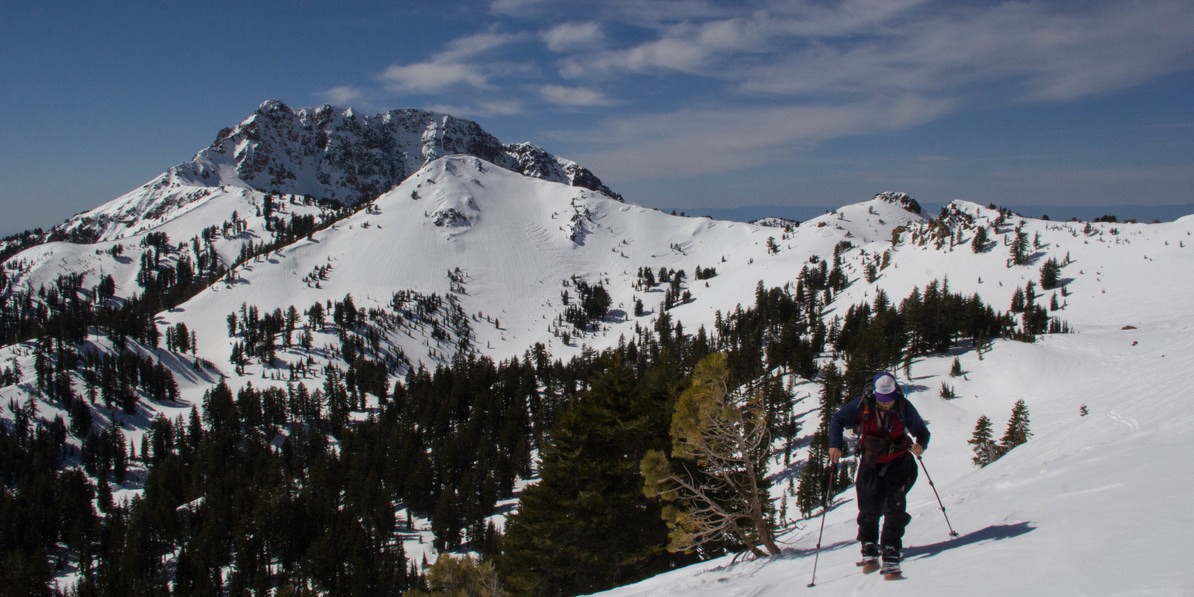
Ski-touring above Ridge Lakes. Photo by Aron Bosworth.
Not surprisingly, the majority of Lassen’s visitors experience the park during summer months when the high elevation roads are fully open and trailheads are easily accessible. During the summer and though much of fall, one can drive the full Lassen Park Road, where Highway 89 connects latitudinally across the park. The Lassen Park Road provides easy access to many Lassen highlights; Lassen Peak Summit Trail, Kings Creek Falls, Bumpass Hell, Summit Lake, the Devastated Area and Hat Creek and Paradise Meadows are all within relatively easy reach from the Park Road. Following the first significant snowfall of the season, however, the Park Road typically shuts down between Kohm Yah-mah-nee Visitor Center and Manzanita Lake or the Devastated Area. This typically happens around early November until early June, at which point one will have to travel long distances over snow to access the park’s interior.
While it does limit access, the abundant snowfall is one of Lassen Volcanic National Park's greatest attributes. Experiencing Lassen's active volcanic landscape and impressive topographic relief blanketed in white can feel like an other-worldly experience, and a network of winter trails provides plentiful access. In addition to snowshoe and cross-country ski trails and family-oriented snow activities, Lassen's terrain offers diverse ski-touring and climbing opportunities for those inspired to earn their turns. Note there is no avalanche bulletin available for the Lassen area; backcountry enthusiasts should take precautions and become educated about winter backcountry travel, avalanche rescue training and risk avoidance.
Located at 6,700 feet, the southwest entrance and Kohm Yah-mah-nee Visitor Center is the main gateway for winter recreation in the park. From there multiple winter trails are accessible, and the Southwest Walk-in Campground remains open year round. The park allows overnighters to stay in vehicles in the parking area during winter and restrooms in the visitor center remain open 24 hours a day. During snow-covered months, the Lassen Park Road offers a user-friendly snowtrack for snowshoers and cross-country skiers. The Manzanita Lake entrance also offers winter recreation activities, but due to its lower elevation, there is typically less snow than at the Kohm Yah-mah-nee Visitor Center.
Camping and Lodging
Camping
- Ridge Lakes Winter Camp sits at 8,000 feet and is located in a striking Cascade alpine setting. It is an ideal base camp from which to explore the park during winter months. Ridge Lakes isn't accessible by car, and water is unavailable at the campground. Because the lakes freeze in the winter, bringing lots of fuel to melt snow for drinking water is a necessity.
- Located one mile east of the Manzanita Lake Entrance, Manzanita Lake Campground is a popular campground with easy access to kayaking, swimming, fishing, and hiking. It generally opens in late May and closes in late November. RVs and trailers up to 40 feet are permitted at the campground. Amenities at the campground include a camp store, a gift shop, kayak rentals, coin operated showers, and a laundromat. Flush toilets and potable water are available until October, and vault toilets are available for the rest of the season. Reservations can be made for half the sites in the campground, except during October and November, when all sites are walk-in only.
- Southwest Walk-In Campground is the park's only year-round campground. The campground provides vault toilets and potable water on site from May through October and heated toilets and potable water in the nearby Kohm Yah-mah-nee Visitor Center during the winter. The campground itself is tents only, but overnight parking is allowed in the parking lot for RVs and trailers.
- Summit Lake North and South Campground are both near the shore of Summit Lake. The South Campground is generally open mid-July until late September. The North Campground's season is slightly shorter, opening later in July and closing in early September. Sites for RVs and trailers up to 35 feet are available in the North Campground. Potable water is available at both campgrounds, and there are flush toilets in the North Campground and vault toilets in the South. Reservations can be made online, although the South Campground becomes walk-in only in the later half of September.
- Butte Lake Campground is located 6 miles south of Highway 44, and is open from early June until late October. Swimming, hiking, non-motorized boating are some popular activities at the campground, and the Snag Lake area, Painted Dunes, Bathtub Lake area are all nearby. RVs and trailers up to 35 feet are permitted at the campground. Potable water and vault toilets are available at the campground. Reservations can be made on for sites in Loop B until early September.
- The Juniper Lake Campground is located on the eastern shore of Juniper Lake, and it is accessible by a 13-mile paved/gravel road. Due to the rough gravel road, buses, motor homes, and trailers are not recommended at this campsite. The campground is generally open from late July until early October. Potable water is unavailable at Juniper Lake. Pit toilets are available. The entire campground is first-come, first-served.
- Open early June until late October, Warner Valley Campground is located a mile north of the Warner Valley Ranger Station and is close to Drakesbad Guest Ranch. Trailheads to Terminal Geyser, Boiling Springs Lake, Drake Lake, and Devils Kitchen are all close by. RVs and trailers are not recommended for this campground. Potable water and vault toilets are available. This campground does not take reservations.
Lodging
- Sitting in the Warner Valley area, Drakesbad Guest Ranch is open early June through early October with both hotel style rooms and cabins. A full service restaurant ensures guests are well fed. The ranch provides an unplugged experience, as Wi-Fi is unavailable and cell service is spotty. Pets are not permitted. Reservations can be made on their website.
- Without electricity or running water, staying in the Manzanita Lake Cabins just north of Manzanita Lake is basically camping, and guests should come prepared with items like flashlights and sleeping bags. The cabins are heated and have picnic tables, a fire ring, and bear-proof food storage outside. Wi-Fi is unavailable. Pets are not permitted inside the cabins, although they can sleep leashed outside or in a vehicle. Reservations can be made on recreation.gov.
Pets
As is the case in most national parks, pets are allowed with quite a few restrictions. Pets are not allowed on trails or in the backcountry. Roads, parking lots, and campgrounds are fair game, but they must remain leashed and attended. Pets may be left in vehicles, but keep in mind that the climate can become quite severe; owners can be fined for endangerment. The park is surrounded by Lassen National Forest, so there are plenty of opportunities for pet-friendly adventures nearby.
Logistics + Planning
Current Weather: Powered by Dark Sky








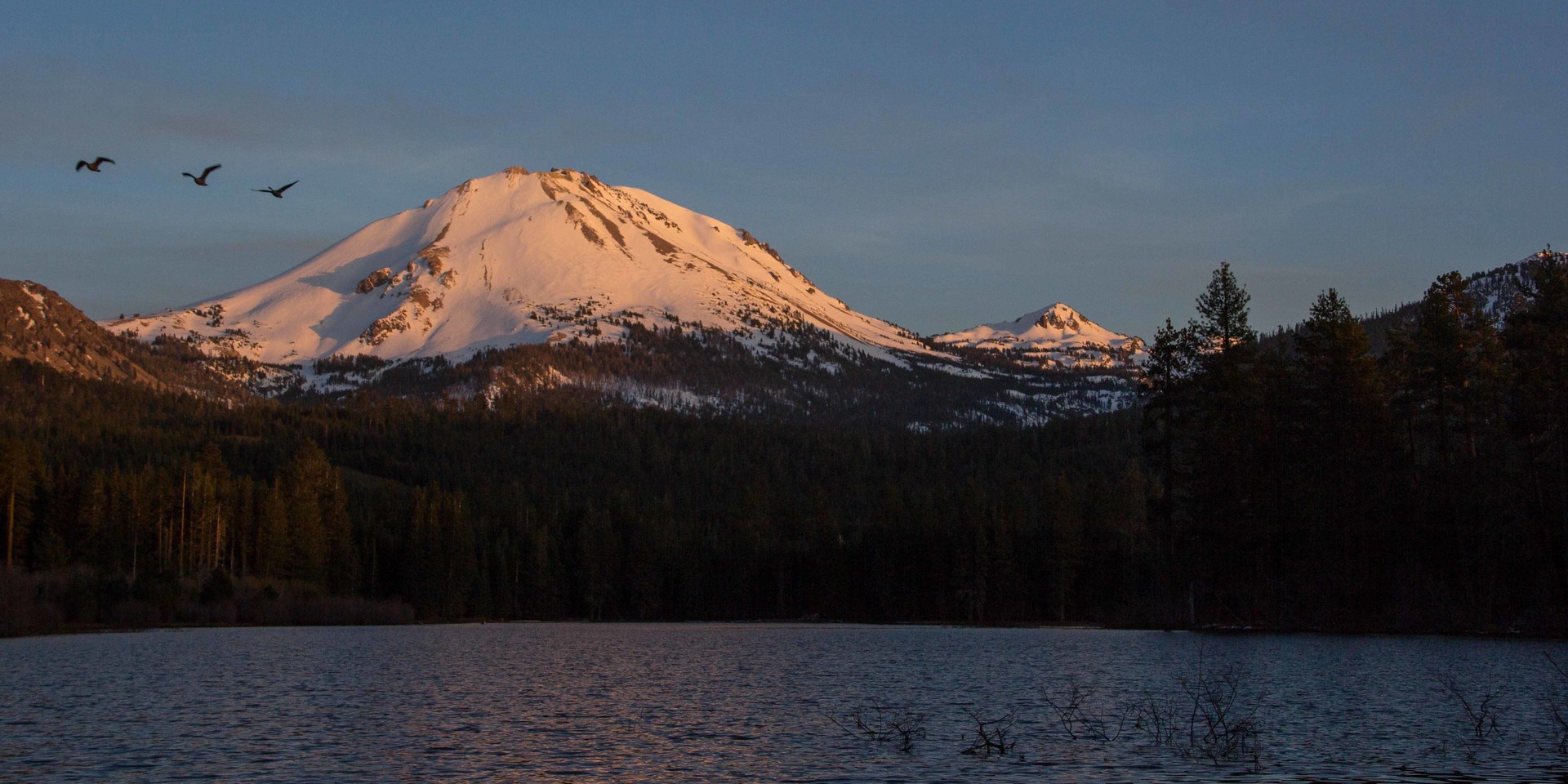















Comments
Sign In and share them.